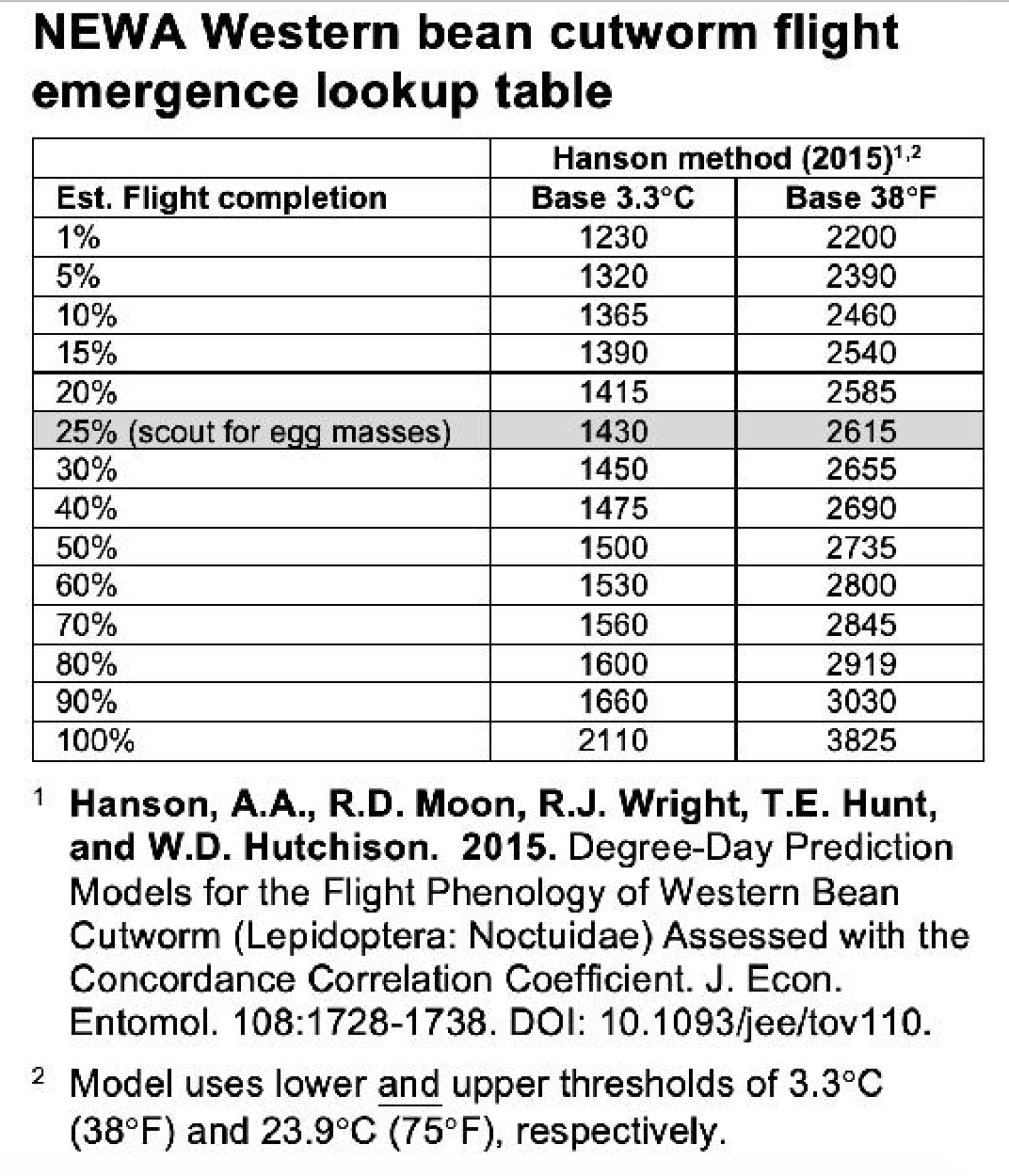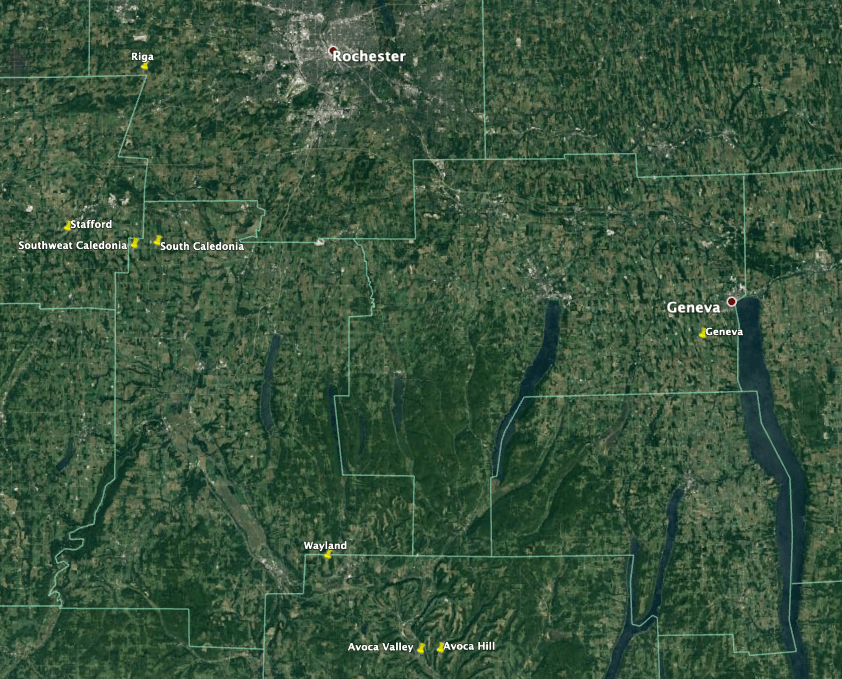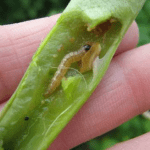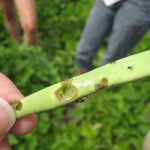Thirty-five sites reported this week. Twelve of the sites had European corn borer (ECB)-E and eleven sites had ECB-Z. Eighteen sites reported corn earworm (CEW) with thirteen high enough to be on a 4, 5 or 6 day spray interval (see table at bottom of post). Fall armyworm (FAW) was caught at fifteen sites and Western bean cutworm (WBC) was caught at twenty-eight sites. The hybrid ECB moth was caught at three of the six reporting sites.
Below is a graph showing the average trap catch for all reporting sites since the beginning of the trapping season. WBC really went up this week, but there was an increase in trap catches for all the moths over the last three weeks.
The table below shows the estimated WBC flight completion based on Hanson et al. with a summary written by Dan Olmstead, NEWA coordinator.
Summary of Hanson et al. (2015) by Dan Olmstead:
A group from University of Minnesota published a revised method for predicting western bean cutworm flight periods in 2015. The older literature, commonly referred to as the ‘Nebraska method’ was published in 1976. The new method, referred to as the ‘Hanson method,’ noted WBC range expansion into Northern and Eastern US regions where suitable temperatures before the historical model start date of May 1 may occur.
The Minnesota group used historical WBC black-light trap data from Nebraska to compare actual 25% flight completion dates with predicted values derived from a variety of candidate models having different lower and upper development thresholds using both simple and modified sine wave degree day calculations.
The best fit model proved to be one using a lower threshold of 3.3°C (38°F), an upper threshold of 23.9°C (75°F) and a simple daily degree day calculation.
To determine the estimated flight prediction of the sweet corn sites, use the degree days in the table below. Degree days were calculated using a base 38°F but not the upper threshold of 75°F. The degree days are therefore overestimated a bit.
| Location | ECB-E | ECB-Z | Hybrid | CEW | FAW | WBC | DD | |
| Western NY trap Catch |
||||||||
| Attica (Wyoming Co.) | 0 | 0 | NA | 0 | 0 | 0 | 2589 | |
| Baldwinsville (Onondaga Co.) | 2 | 0 | NA | 10 | 0 | 31 | 2685 | |
| Batavia (Genesee Co.) | NA | 1 | NA | 1 | 0 | 84 | 2647 | |
| Bellona (Yates Co.)* | 0 | 4 | 1 | 0 | 3 | 56 | 2662 | |
| Brockport (Monroe Co.) | 1 | 1 | NA | 3 | 1 | 0 | 2739 | |
| Eden (Erie Co.) | 0 | 1 | NA | 3 | 15 | 12 | 2656 | |
| Farmington (Ontario Co)* | 0 | 0 | 0 | 0 | 0 | 1 | 2733 | |
| Geneva (Ontario Co.)* | 45 | 0 | 14 | 6 | 3 | 18 | 2669 | |
| Hamlin (Orleans Co.) | 0 | 0 | NA | 4 | 1 | 2 | 2635 | |
| Kennedy (Chautauqua Co.) | NA | NA | NA | NA | NA | NA | 2515 | |
| King Ferry (Cayuga Co.) | 0 | 0 | NA | 1 | 2 | 4 | 2536 | |
| Kirkville (Madison Co.) | 5 | 0 | NA | 0 | 0 | 25 | 2636 | |
| LeRoy (Genesee Co.) | 4 | 3 | NA | 1 | 2 | 2 | 2629 | |
| Lyndonville (Orleans Co.) | 1 | 0 | NA | 1 | 1 | 128 | 2568 | |
| Oswego (Oswego Co.) | 0 | 0 | NA | 0 | 0 | 26 | 2416 | |
| Panama (Chautauqua Co.) | 0 | 10 | NA | 0 | 0 | 0 | 2360 | |
| Penn Yan (Yates Co.)* | 0 | 0 | 0 | 0 | 0 | 1 | 2578 | |
| Portville (Cattaraugus Co.) | 0 | 0 | NA | 0 | 2 | 8 | 2331 | |
| Preble (Cortland Co.) | 0 | 0 | NA | 0 | 0 | 36 | 2243 | |
| Ransomville (Niagara Co.) | 0 | 1 | NA | 0 | 1 | 9 | 2671 | |
| Seneca Castle (Ontario Co.)* | 0 | 0 | 0 | 0 | 0 | 2 | 2613 | |
| Sherwood (Cayuga Co.) | NA | NA | NA | NA | NA | NA | 2571 | |
| Williamson (Wayne Co.) | 0 | 0 | NA | 1 | 1 | 0 | 2465 | |
| Eastern NY trap Catch |
||||||||
| Amsterdam (Fulton Co.) | NA | NA | NA | NA | NA | NA | 2496 | |
| Feura Bush (Albany Co.) | 0 | 0 | NA | 0 | 0 | 1 | 2765 | |
| Florida (Orange Co.) | 2 | 0 | NA | 23 | 84 | 5 | 2876 | |
| Greenwich (Washington Co.) | 2 | 1 | NA | 4 | 6 | 4 | 2684 | |
| Hurley (Ulster Co.)* | 19 | 3 | 2 | 12 | 0 | 4 | 2771 | |
| Kinderhook (Columbia Co.) | 0 | 0 | NA | 7 | 0 | 7 | 2793 | |
| Melrose (Rensselear Co.) | 0 | 0 | NA | 3 | 0 | 5 | 2714 | |
| Middleburgh (Schoharie Co.) | NA | NA | NA | NA | NA | NA | 2772 | |
| New Paltz (Ulster Co.) | 1 | 0 | NA | NA | NA | 0 | 2930 | |
| Peru (Clinton Co.) | 0 | 0 | NA | 0 | 0 | 182 | 2528 | |
| Plattsburgh (Clinton Co.) | 0 | 0 | NA | 0 | 0 | 279 | 2584 | |
| Plessis (Jefferson Co.) | 0 | 2 | NA | NA | 4 | 101 | 2646 | |
| South Colton (St. Lawrence Co.) | NA | NA | NA | NA | NA | NA | 2304 | |
| Stone Ridge (Ulster Co.) | 13 | 0 | NA | 2 | NA | NA | 2698 | |
| Ticonderoga (Essex Co.) | 0 | 0 | NA | 3 | 0 | 40 | 2569 | |
| Tivoli (Dutchess Co.) | 1 | 6 | NA | 2 | NA | NA | 2904 | |
| Unadilla (Delaware Co.) | 0 | 0 | NA | 0 | 2 | 15 | 2258 | |
| ECB – European Corn Borer CEW – Corn Earworm FAW – Fall Armyworm WBC – Western Bean Cutworm NA – not available DD – Degree Day (base 38) March 1st accumulation Climate Smart Farming |
||||||||
| trap catches for the week of 7.21.20 – 7.28.20 |
||||||||
Dry Bean Western Bean Cutworm Alert
7.28.20
Marion Zuefle, NYS IPM Program and Margie Lund, CVP
(Information and photos from T. Baute, OMAFRA)
This year we are monitoring eight WBC traps placed next to dry bean fields. The location of the traps are given in the image below. Dry bean growers should scout adjacent corn for WBC eggs and larvae when cumulative trap catch reaches 50 moths. This week seven of the eight sites we are monitoring (all except Wayland) reached the 50 moth threshold. Peak WBC flight historically occurs the last week of July into early August. All dry bean growers should begin scouting pods for WBC feeding about 10 days after peak flight regardless of cumulative trap catch, and should continue to scout for three weeks, especially if damage has been seen in recent years.
Check 10 random spots in a field, 5 plants per spot. Inspect all the pods on the plants looking for holes. Surface feeding can be caused by other insects. WBC will mine directly into the pod and will often feed on the seed inside. European corn borer will also feed inside the pod and would most likely still be present (see image below). Slugs will also feed on the pods causing similar damage, but will often leave a slime trail (image below). If there is damage going directly into the pod and seed but no larva present, it is quite possibly WBC. During the day WBC larva are not actively feeding in the pod, instead they drop to the soil and will remain there until night. Fresh damage will be green, not brown.
- Early damage made by small WBC larvae.
- ECB in pod.
- Damage caused by slug feeding, note slime trail.
- Later feeding damage going through pod and into beans.
| Dry Bean Location | 7.7.20 | 7.14.20 | 7.21.20 | 7.28.20 | Cumulative WBC | ||
| Avoca Hill (Steuben Co.) | 0 | 0 | 23 | 67 | 90 | ||
| Avoca Valley (Steuben Co.) | 1 | 0 | 6 | 44 | 51 | ||
| Caledonia South (Livingston Co.) | 0 | 0 | 6 | 54 | 60 | ||
| Caledonia Southwest (Livingston Co.) | 0 | 0 | 8 | 100 | 108 | ||
| Geneva (Ontario Co.) | 0 | 2 | 13 | 38 | 53 | ||
| Riga (Monroe Co.) | 0 | 1 | 24 | 49 | 74 | ||
| Stafford (Genesee Co.) | 1 | 1 | 18 | 41 | 61 | ||
| Wayland (Steuben Co.) | 0 | 2 | 4 | 24 | 30 | ||
| Western Bean Cutworm trap counts by date | |||||||
This project is funded by the NYS Dry Bean Industry.








